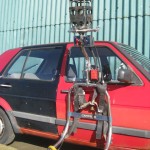 Now pardon me for I nearly started this as an almost nifty swiftly debunkle of the original Cameron Skyhopper but after a bit of thought and consideration that is really not the case at all, in fact its an almost ‘what, if, but’ appraisal. Trouble is I have the memory of disappointment of the first (not sure if was really the first) commercial Cameron H-type balloon but I’m certain someone out there will put me right. The brand new Shell Unleaded H-20, G-BRCO and operated by HABCO, or it may have been Flying Pictures by then, was delivered by Tom Sage out the back of his car to us at The Royal Show on the 4th July 1989. It didn’t capture our hearts. Now although this is about the Skyhopper bottom end rather than the envelope one has to bear in mind the Skyhopper was intended to be sold as a package, as we will discover, so initially we’ll have a quick glance at what may have been the complete concept and the commercial thought behind it.
Now pardon me for I nearly started this as an almost nifty swiftly debunkle of the original Cameron Skyhopper but after a bit of thought and consideration that is really not the case at all, in fact its an almost ‘what, if, but’ appraisal. Trouble is I have the memory of disappointment of the first (not sure if was really the first) commercial Cameron H-type balloon but I’m certain someone out there will put me right. The brand new Shell Unleaded H-20, G-BRCO and operated by HABCO, or it may have been Flying Pictures by then, was delivered by Tom Sage out the back of his car to us at The Royal Show on the 4th July 1989. It didn’t capture our hearts. Now although this is about the Skyhopper bottom end rather than the envelope one has to bear in mind the Skyhopper was intended to be sold as a package, as we will discover, so initially we’ll have a quick glance at what may have been the complete concept and the commercial thought behind it.
Up to this point the only hoppers I’d flown were the old Thunder type with the garden swingseat hanging off a couple of ears with a cylinder bolted on, or was that the other way round, and what was a barely disguised Hot Tom. Well that’s not quite true but looking at it today the burner is basic but I still like it. What you could do with the Thunder hoppers was behave abysmally. The burner was sufficient and the envelope a delight. It roared up and down and even the heartiest of heaves on the ripline wouldn’t stall the parachute. You could make it look very alarming from the ground. They also kept Tony Patey happy as repairs were not uncommon as a result of the small mouth and all this dashing about the sky. The Skyhopper set-up was a different as could be. For a kick-of there were only three suspension points on the burner ring which had to marry up with three sets of five flying wires of the fifteen gore envelope. We asked Tom why it was built like that and he was vague (even by his standards) but sort of said it was a package! We sort of said it would be difficult to use it with any envelope where the flying wires were not divisible by three! Love all. “Yes,” he said, “Its designed to be sold as a package not to be used with other envelopes. You clearly don’t get it.” We admitted that we didn’t. Advantage Tom. Future sales clearly proved the point. The mouth was huge as was the parachute, too huge as it turned out. We took it up on a tether and pulled the red line. The parachute floated about and eventually, try as we may, it didn’t go back and we arrived back on the deck in a large heap followed by the envelope. “You’re not supposed to use the parachute like that!’ exclaimed a clearly surprised Tom. Deuce. We tied the centre of the parachute to the crown ring and all was a little bit better. Hey ho, best remember that then! This also showed up a sort of problem with the seat assembly in that, in my case, with the Thunder Cloudhopper the cylinder crumped into the ground before me taking a fair amount of the impact but the seat of the Skyhopper hung below the cylinder so my arse ended up taking the arrival. The bottom end looked rather dinky and first realisation was that it had a tendency to pinch fingers when it didn’t fold or unfold properly, as in it didn’t fold up properly. So not properly it took up a lot room. The twist grip was a novel idea but practical? We’d have to see. The burner looked just like a mini-Mark 4 and blow me down it had square coils. Why, Oh why? We didn’t bother asking the knowledgeable Tom. It would have been so much better with a round one, even a slightly rounder one would do. The seat was comfortable enough and with big levers for the pilot light and one that switched the blast valve function between Main and Whisper it was all fine. So the first impression was that, smart as it all looked, it did not inspire confidence if you wanted to do any proper yahooing. The following day we headed for Silverstone and a very windy tether. It became apparent that the bottom end didn’t do windy tethers and that you had to be extremely careful not to activate the twist grip accidentally. We disconnected it and things improved. A free flight was clearly needed and in fine conditions, I have to say, it was most enjoyable, a bit of a fag to have to switch between Main and Whisper as the lever was rather stiff but all in all it was sedate and distinctly ‘gentleman’s’ hopping. A few odd flights were made in it in much windier conditions and it was hard work with the handles tending to catch and cause the whole shooting match to rock and roll on drag landings. September came along and we headed off in support of the Autoglass Round Britain Rally but that is another story and I can only say that apart from having a fine old time doing 29 tethers and free flights in eight days we managed to prove that the Skyhopper bottom end and fast landings are not compatible but for 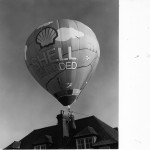 putting stars and famous people in on calm days for photo-shoots it is absolutely the best, as long as you disconnect the twist grip! The bottom end stood the punishment surprisingly well with only the twist grip and cable completely destroyed and the seat and arms rather battered. Actually the arms were, and continue to be, the downside. I recall being dressed as Father Christmas and having a devil’s own job trying to get up a chimney with a sack load of presents as the arms just kept getting in the way and fouling the brickwork but I accept that is probably not what it was designed for.
putting stars and famous people in on calm days for photo-shoots it is absolutely the best, as long as you disconnect the twist grip! The bottom end stood the punishment surprisingly well with only the twist grip and cable completely destroyed and the seat and arms rather battered. Actually the arms were, and continue to be, the downside. I recall being dressed as Father Christmas and having a devil’s own job trying to get up a chimney with a sack load of presents as the arms just kept getting in the way and fouling the brickwork but I accept that is probably not what it was designed for.
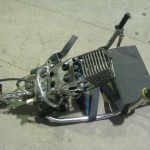 So getting back to the original point of this, is the Cameron Skyhopper bottom end any good? Well now it all depends on what you want. The combined burner seat unit sort of folds in half for travelling but does take up rather more room than it ought. There is no need to disconnect the cable from the twist grip to blast valve but you do need to make sure it doesn’t get snagged during handling. There is a lead from the cylinder to the warning buzzer which does need to be un-plugged before removing the cylinder. It isn’t that easy to carry on your own it isn’t that heavy, just awkward and probably, in reality, only slightly heavier than the Colt Cloudhopper bottom end. If you have to carry it out, your trusty retrieve is to hand and the fuel is almost all gone then it is easier to carry it rigged. There is nothing complicated about unfolding it and bolting it to a master cylinder (they use a vapour pilot light) using two M12 bolts, washers and wing nuts but again its just awkward. This really is an awful lot easier with two people and should prevent loss of fingers when it all tries to fold up! There is a modification allowing two cylinders to be used, which is a bonus, but the only approved cylinder that can be used is a Worthington. In the case of twin cylinder operation, apart from being bolted to a thick aluminium plate at the top, they are also drilled through the guard rings top and bottom and, using a spacer, so form a fixed unit.
So getting back to the original point of this, is the Cameron Skyhopper bottom end any good? Well now it all depends on what you want. The combined burner seat unit sort of folds in half for travelling but does take up rather more room than it ought. There is no need to disconnect the cable from the twist grip to blast valve but you do need to make sure it doesn’t get snagged during handling. There is a lead from the cylinder to the warning buzzer which does need to be un-plugged before removing the cylinder. It isn’t that easy to carry on your own it isn’t that heavy, just awkward and probably, in reality, only slightly heavier than the Colt Cloudhopper bottom end. If you have to carry it out, your trusty retrieve is to hand and the fuel is almost all gone then it is easier to carry it rigged. There is nothing complicated about unfolding it and bolting it to a master cylinder (they use a vapour pilot light) using two M12 bolts, washers and wing nuts but again its just awkward. This really is an awful lot easier with two people and should prevent loss of fingers when it all tries to fold up! There is a modification allowing two cylinders to be used, which is a bonus, but the only approved cylinder that can be used is a Worthington. In the case of twin cylinder operation, apart from being bolted to a thick aluminium plate at the top, they are also drilled through the guard rings top and bottom and, using a spacer, so form a fixed unit.
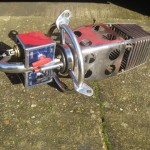 The burner is actually pretty good and would probably be fine on anything up to a ’56. As there is a change-over you cannot use the whisper and blast valve together. The blast valve is a Bonanno-style Rego so no problems with leaking down the stem and it doubles up as the valve for the whisper or main burner depending on the position of the change-over valve which is a ball-type similar to the simple on-off pilot valve. There is no mirror fitted as standard to allow a view of the contents gauge but provided the original cylinder is used there is an audible warning (intermittent) when you get down to about 25% and another ‘time to crash’ one at that goes from 10% until 5%. After that its all rather academic. There is a ‘test switch for the alarm and if it stays silent you’ll need a screwdriver and 9 volt PP3 battery. With the twin cylinder version the warning is only fitted to the master cylinder. If you are double jointed you can just about operate a quick shut off valve from the seat but it isn’t really practical so if you fly with two cylinders they will both need to be live at lift-off. The igniter is built into the burner and is a simple Piezo type which works well enough and is still available as a spare as are seals for the Bonanno valve. Now the downside. All the piping for the burner goes through the main vertical tube around which the swivel rotates and it is either a feat of pure genius or created at ten to six on a Friday. Leaks, although not a feature, are a devil of a job to sort as every bit of pipework loops around the next. They may as well be plaited. Once the trim and covers are off access to the Bonanno valve is fine but the whisper and change-over ones are well fiddly and sadly no spares are available for these. Colin Wolstenholme, formally of Cameron Balloons, did track down some spares but you are looking at a very expensive repair if they leak. Hoses are straightforward to change and if you use twin tanks
The burner is actually pretty good and would probably be fine on anything up to a ’56. As there is a change-over you cannot use the whisper and blast valve together. The blast valve is a Bonanno-style Rego so no problems with leaking down the stem and it doubles up as the valve for the whisper or main burner depending on the position of the change-over valve which is a ball-type similar to the simple on-off pilot valve. There is no mirror fitted as standard to allow a view of the contents gauge but provided the original cylinder is used there is an audible warning (intermittent) when you get down to about 25% and another ‘time to crash’ one at that goes from 10% until 5%. After that its all rather academic. There is a ‘test switch for the alarm and if it stays silent you’ll need a screwdriver and 9 volt PP3 battery. With the twin cylinder version the warning is only fitted to the master cylinder. If you are double jointed you can just about operate a quick shut off valve from the seat but it isn’t really practical so if you fly with two cylinders they will both need to be live at lift-off. The igniter is built into the burner and is a simple Piezo type which works well enough and is still available as a spare as are seals for the Bonanno valve. Now the downside. All the piping for the burner goes through the main vertical tube around which the swivel rotates and it is either a feat of pure genius or created at ten to six on a Friday. Leaks, although not a feature, are a devil of a job to sort as every bit of pipework loops around the next. They may as well be plaited. Once the trim and covers are off access to the Bonanno valve is fine but the whisper and change-over ones are well fiddly and sadly no spares are available for these. Colin Wolstenholme, formally of Cameron Balloons, did track down some spares but you are looking at a very expensive repair if they leak. Hoses are straightforward to change and if you use twin tanks 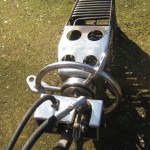 then you’ll be needing a manifold. The twistgrip unit is a good quality motorcycle type and the cable easy enough to make up. Removal of the cable at the blast valve end is easy should you go down that route. If, during your pre-flight checks, there is any sticking of the cable, disconnect it. You can operate the blast valve with the cable attached so don’t panic if it sticks during flight. Access to the pilot light with a stick-type piezo striker is fine but its best to practice before flight. The shut off time for the pilot light and main burner is very quick and the pilot normally extinguishes very quickly.
then you’ll be needing a manifold. The twistgrip unit is a good quality motorcycle type and the cable easy enough to make up. Removal of the cable at the blast valve end is easy should you go down that route. If, during your pre-flight checks, there is any sticking of the cable, disconnect it. You can operate the blast valve with the cable attached so don’t panic if it sticks during flight. Access to the pilot light with a stick-type piezo striker is fine but its best to practice before flight. The shut off time for the pilot light and main burner is very quick and the pilot normally extinguishes very quickly.
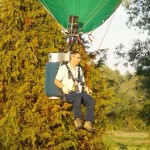 The seat and harness are straightforward and give the pilot a good sense of security. The harness is a four point type. Two straps come down over your shoulders and two come from the sides under your legs and up between then. Make sure that the lower ones are inside of the seat support rods unlike the example shown! Landing, unless its flat calm must be made backwards. The arms and seat do dig in at the slightest opportunity so a sideways attempt will result in a good impression of a randomly rotating cement mixer. With the harness set up correctly and tight there is no danger of coming out . The seat is unforgiving and could do with a bit more padding but its fine. It would be improved immensely if it were suspended on loadtapes. If you choose to fly with the twistgrip connected then it very easy to knock it on during either clambering in or during the landing. If you are giving tethered rides then I personally would advise disconnecting the thing or make sure the passenger is told not to touch it whilst getting strapped in.
The seat and harness are straightforward and give the pilot a good sense of security. The harness is a four point type. Two straps come down over your shoulders and two come from the sides under your legs and up between then. Make sure that the lower ones are inside of the seat support rods unlike the example shown! Landing, unless its flat calm must be made backwards. The arms and seat do dig in at the slightest opportunity so a sideways attempt will result in a good impression of a randomly rotating cement mixer. With the harness set up correctly and tight there is no danger of coming out . The seat is unforgiving and could do with a bit more padding but its fine. It would be improved immensely if it were suspended on loadtapes. If you choose to fly with the twistgrip connected then it very easy to knock it on during either clambering in or during the landing. If you are giving tethered rides then I personally would advise disconnecting the thing or make sure the passenger is told not to touch it whilst getting strapped in.
Inflating, we found, was best achieved with the thing on its back and the handly things sticking up. Its best to use the blast valve handle as it is just simply too awkward to use the twistgrip in this configuration whilst trying to keep the plot at the correct angle as you can’t straddle it unless you fancy serious injury. Its quick and easy to get into providing there is someone to assist with the straps. In calmer conditions there are no problems and upward vision once seated is pretty well unimpaired. The three attachment points meant that we ended up just using a single restraint line to the back one or more often a karabiner that you simply unclipped. Lines dangling down getting tangled in the cylinder were never a problem and the unit was well-balanced and rotated easily.
So what can one say truly about them. Historically they never made and sold that many and the idea of a dedicated envelope, especially one that was as staid and as heavy as the H-type, was less than a good selling point and probably the main reason. The perfect ‘cloudhopper’ design clearly didn’t suit many folk. As an answer to the Thunder & Colt it was brave and a lot more user friendly but price and the three point attachment didn’t cut it and by then the new T&C hopper was well on the way. We often flew the Unleaded balloon on a Cloudhopper bottom end but the H-series envelope was a dog to fly in all honesty and you ended up with an uneven spread of wires. The upside was that you could fit more stuff in the trusty Ford Sierra we had for it if you used the Cloudhopper bottom end and it was easier to inflate and tether it if it was windy. I seem to recall Trish Watkins volunteered to take it off us and use it for the British Gas Cloudhopper and loved it. If you go the other way the problem isn’t actually that bad as most hoppers are 12 or 24 gore so providing you get one double flying wire remade as two separate ones its fine. If you’ve got a 28 or 32 gore jobbie you’ll just have to make the best of it, however scoop alignment can be a problem. Spares may become a problem but then again the components appear reliable and if push came to shove and you had an Annex 2 rig then it wouldn’t be that difficult to work out a way to incorporate different valves. Then I remembered the convoluted plumbing and maybe it would. 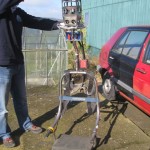 Did they nearly get it right? Yes, actually I think they did. Had they broken tradition and had a nicely rounded coil, made the thing fold up in a better way, dumped the twistgrip and designed it with four flying wire attachment points they would have had a winner on their hands. Having said that with the twistgrip attached it was really a Gentleman’s one man balloon but only when it was nice. Push it to its limits and it won’t, didn’t, wasn’t, but in calmer conditions there is no denying it is user friendly. Would I buy one? No, but ask me in another ten years time.
Did they nearly get it right? Yes, actually I think they did. Had they broken tradition and had a nicely rounded coil, made the thing fold up in a better way, dumped the twistgrip and designed it with four flying wire attachment points they would have had a winner on their hands. Having said that with the twistgrip attached it was really a Gentleman’s one man balloon but only when it was nice. Push it to its limits and it won’t, didn’t, wasn’t, but in calmer conditions there is no denying it is user friendly. Would I buy one? No, but ask me in another ten years time.
Cameron Flight Manual Supplement HABFM Issue10-8.32 ‘Out Production Hoppers’ covers the Skyhopper but doesn’t show the harness arrangement. Download from the Cameron Website http://www.cameronballoons.co.uk/support#hot-air-balloon-flight-manual-supplements-en